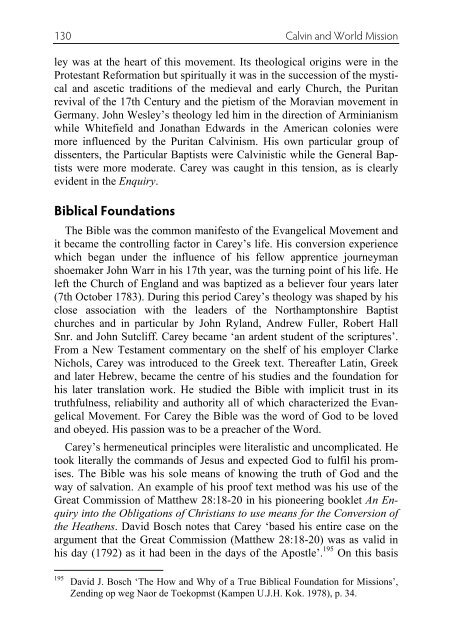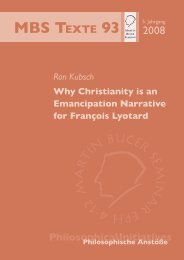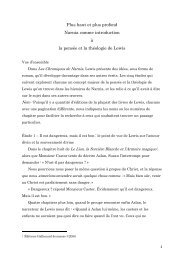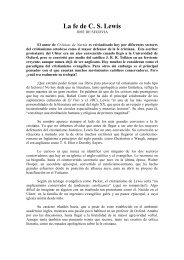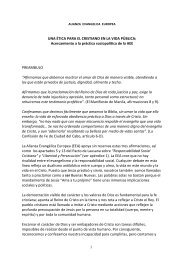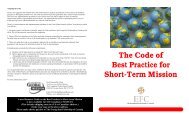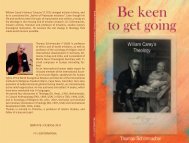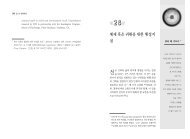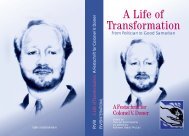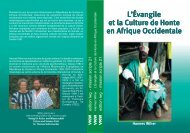Calvin and Missions - World Evangelical Alliance
Calvin and Missions - World Evangelical Alliance
Calvin and Missions - World Evangelical Alliance
You also want an ePaper? Increase the reach of your titles
YUMPU automatically turns print PDFs into web optimized ePapers that Google loves.
130 <strong>Calvin</strong> <strong>and</strong> <strong>World</strong> Mission<br />
ley was at the heart of this movement. Its theological origins were in the<br />
Protestant Reformation but spiritually it was in the succession of the mystical<br />
<strong>and</strong> ascetic traditions of the medieval <strong>and</strong> early Church, the Puritan<br />
revival of the 17th Century <strong>and</strong> the pietism of the Moravian movement in<br />
Germany. John Wesley’s theology led him in the direction of Arminianism<br />
while Whitefield <strong>and</strong> Jonathan Edwards in the American colonies were<br />
more influenced by the Puritan <strong>Calvin</strong>ism. His own particular group of<br />
dissenters, the Particular Baptists were <strong>Calvin</strong>istic while the General Baptists<br />
were more moderate. Carey was caught in this tension, as is clearly<br />
evident in the Enquiry.<br />
Biblical Foundations<br />
The Bible was the common manifesto of the <strong>Evangelical</strong> Movement <strong>and</strong><br />
it became the controlling factor in Carey’s life. His conversion experience<br />
which began under the influence of his fellow apprentice journeyman<br />
shoemaker John Warr in his 17th year, was the turning point of his life. He<br />
left the Church of Engl<strong>and</strong> <strong>and</strong> was baptized as a believer four years later<br />
(7th October 1783). During this period Carey’s theology was shaped by his<br />
close association with the leaders of the Northamptonshire Baptist<br />
churches <strong>and</strong> in particular by John Ryl<strong>and</strong>, Andrew Fuller, Robert Hall<br />
Snr. <strong>and</strong> John Sutcliff. Carey became ‘an ardent student of the scriptures’.<br />
From a New Testament commentary on the shelf of his employer Clarke<br />
Nichols, Carey was introduced to the Greek text. Thereafter Latin, Greek<br />
<strong>and</strong> later Hebrew, became the centre of his studies <strong>and</strong> the foundation for<br />
his later translation work. He studied the Bible with implicit trust in its<br />
truthfulness, reliability <strong>and</strong> authority all of which characterized the <strong>Evangelical</strong><br />
Movement. For Carey the Bible was the word of God to be loved<br />
<strong>and</strong> obeyed. His passion was to be a preacher of the Word.<br />
Carey’s hermeneutical principles were literalistic <strong>and</strong> uncomplicated. He<br />
took literally the comm<strong>and</strong>s of Jesus <strong>and</strong> expected God to fulfil his promises.<br />
The Bible was his sole means of knowing the truth of God <strong>and</strong> the<br />
way of salvation. An example of his proof text method was his use of the<br />
Great Commission of Matthew 28:18-20 in his pioneering booklet An Enquiry<br />
into the Obligations of Christians to use means for the Conversion of<br />
the Heathens. David Bosch notes that Carey ‘based his entire case on the<br />
argument that the Great Commission (Matthew 28:18-20) was as valid in<br />
his day (1792) as it had been in the days of the Apostle’. 195 On this basis<br />
195 David J. Bosch ‘The How <strong>and</strong> Why of a True Biblical Foundation for <strong>Missions</strong>’,<br />
Zending op weg Naor de Toekopmst (Kampen U.J.H. Kok. 1978), p. 34.


